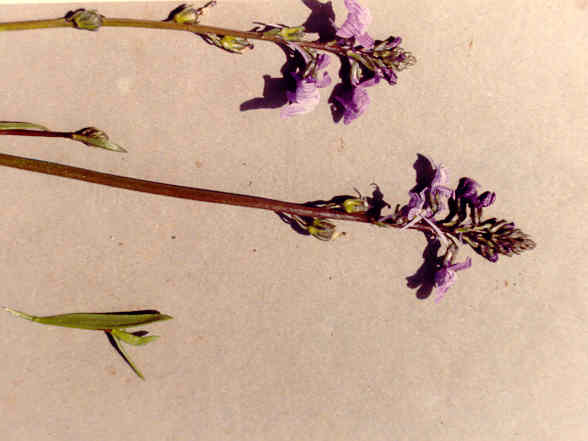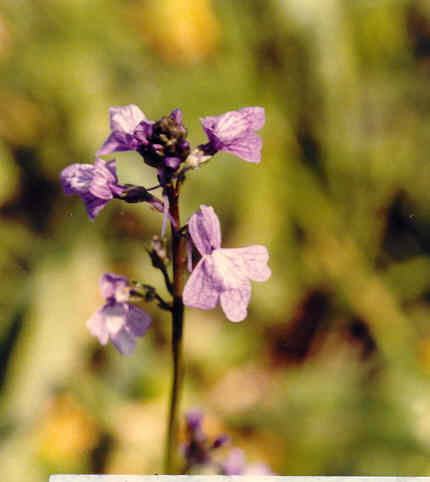
Linaria canadensis (L.) Dum-Cours.
 |
Linaria canadensis (L.) Dum-Cours.
Scrophulariaceae (Figwort Family)NativeBlue Toad-Flax |
March Photo
Plant Characteristics:
Slender annual or biennial, 1-6 dm. high, with short-trailing basal
offshoots; cauline lvs. narrowly linear, sessile, 0.5-2.5 cm. long, those of the
basal sterile stems ovate to linear; racemes spicate, slender, the pedicels 2-10
mm. long; calyx +/- glandular-puberulent, 2-3 mm. long; corolla blue-violet,
with whitish ridges instead of well formed palate, without the spur 9-12 mm.
long, the spur strongly curved, 5-9 mm. long, placed transversely or obliquely;
seeds minutely tubercled.
Habitat:
Dry slopes and waste places, often on burns, below 2000ft.; Coastal Sage
Scrub, Chaparral; L. Calif. to B.C., to Atlantic Coast; S. Am.
March-May.
Name:
Latin, linum, flax, as the lvs. of some spp. are flaxlike.
(Munz, Flora So. Calif. 805).
Canadensis, the first collected specimens were from Canada.
General: Occasional in the study area, found on the bench below Eastbluff North, northerly of the Eastbluff burn area, the Castaway's Bluffs and on the bluffs northerly of 23rd Street. In 2005 a colony was found growing in the sand on the northerly end of Shellmaker Island. (my comments). The fruit is a rounded capsule, many-seeded, and opens by pores or slits just below the tip. (Robbins et al. 397). About 100 species, many in cultivation. (Munz, Flora So. Calif. 805). Linaria vulgaris is a strong , sure, but potentially irritating liver stimulant. It is generally used in combination with other herbs for a liver tonic, cleanser, or "flush." A scant teaspoon is a reasonable amount to consume at one time, along with such herbs as Burdock, Dandelion, Yellow Dock, or Red Root. It is perhaps our best native hepatic remedy for chronic liver inflammations and hepatitis flare-ups. (Moore, Medicinal Plants of the Mountain West 153). The only Linaria species listed in Munz, Flora So. Calif. is L. canadensis var. texana. (my comment). The 1993 Jepson Manual states that plants with larger flowers, and with seeds densely tubercled have been called var. texana; all others are L. canadensis. (Hickman, Ed. 1036). Local specimens are L. canadensis. (my comment). The DNA sequences of various genes, usually those found in the chloroplast of a plant cell, have revealed much about the evolutionary relationships of plants. A gene of even modest length has a variation in DNA sequences that is likely to have more information about evolutionary relationships than the anatomy and morphology on which traditional classifications are based. The genus Linaria will in the future be in the new family Veronicaceae. (Olmstead, Richard G. “Whatever Happened to the Scrophulariaceae?” FREMONTIA A Journal of the California Native Plant Society Vol. 30 No. 2 April 2002 p. 13-22.
Text Ref:
Hickman, Ed. 1036; Munz, Calif. Flora 653; Munz, Flora So.
Calif. 805; Roberts 38.
Photo Ref:
Mar 3 85 # 18,18,20,21.
Identity: by R. De Ruff, confirmed by F. Roberts.
First Found: March 1985.
Computer Ref: Plant Data 278.
Have plant specimen.
Last edit 2/16/05.
 |
March Photo